ROMANIA: BRAN CASTLE
While I was visiting Romania, I was extremely excited to take a day trip from Bucharest to explore and experience Bran Castle – often called Dracula’s Castle – one of the most iconic landmarks in Romania.
Nestled in a picturesque valley near the Carpathian Mountains, on the border of Transylvania and Wallachia and close to the town of Brasov, Bran Castle it is about 160km (100 miles) or a two-and-a-half-hour drive from the Romanian capital Bucharest.
I loved visiting old castles (see Peles Castle) and ancient palaces (see Mogosoaia Palace) while in Romania but I have to admit to feeling particularly fascinated by the famous Bran Castle legend that associates it with Count Dracula!
Built in 1377 on a rocky outcrop that gives the castle a dramatic, spooky, and almost fantasy-like presence, it has a dramatic history, and deep ties to myth and legend.
And, even though I was aware that the association with Dracula and Bran Castle and Vlad the Impaler (the historical figure behind Bram Stoker’s Dracula story) is only tenuous at best, I was far too wrapped up in the glorious and gory gothic tale to be distracted by a historical reality check!
Travel with me to Transylvania and let’s explore Bran Castle and the Dracula connection!
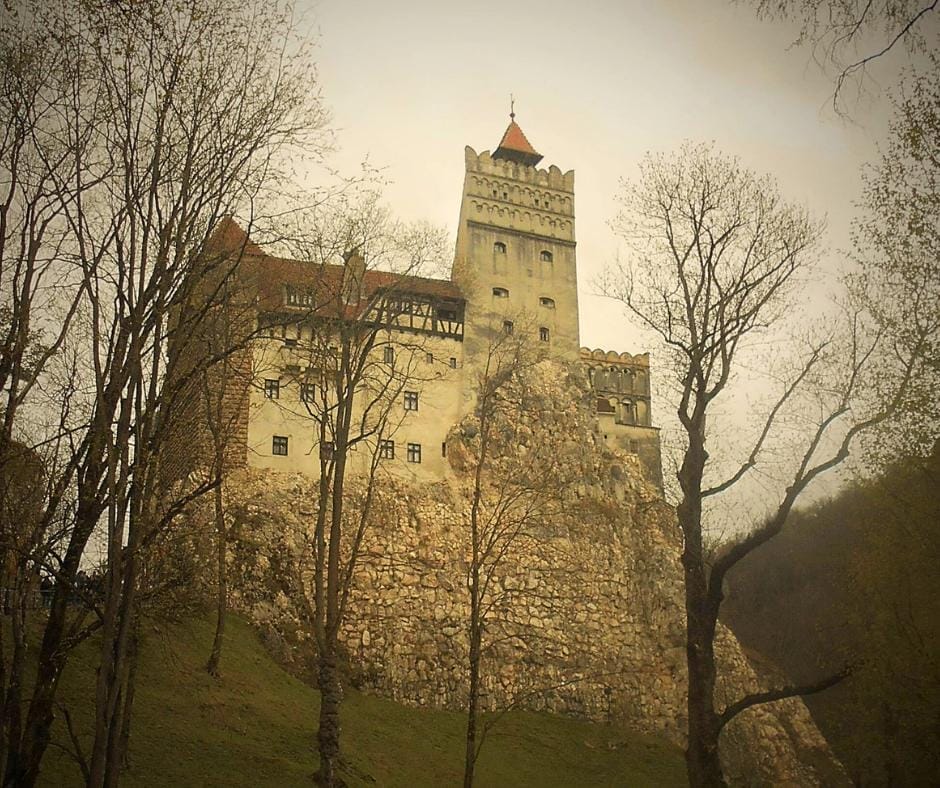
TABLE OF CONTENTS
- BRAN CASTLE ROMANIA
- VLAD THE IMPALER (VLAD III DRACULA)
- VLAD’S TORTURE EXHIBITION AT BRAN CASTLE
- BRAM STOKER’S RESEARCH FOR DRACULA
- GOTHIC HORROR IN WHITBY ENGLAND
- HOW TO VISIT BRAN CASTLE
- BEAT THE RUSH TO ROMANIA!

BRAN CASTLE ROMANIA
Construction began on Bran Castle in the 14th Century after King Louis I of Hungary granted the Saxons of Kronstadt (Brasov) the right to build a stone fortress on a site identified as having a strategic location for defending the mountain pass between Transylvania and Wallachia.
As you can see from my atmospheric photo above – the castle has steep towers, narrow staircases, and stone walls that give it a gothic appearance that’s perfect for fuelling vampire legends!
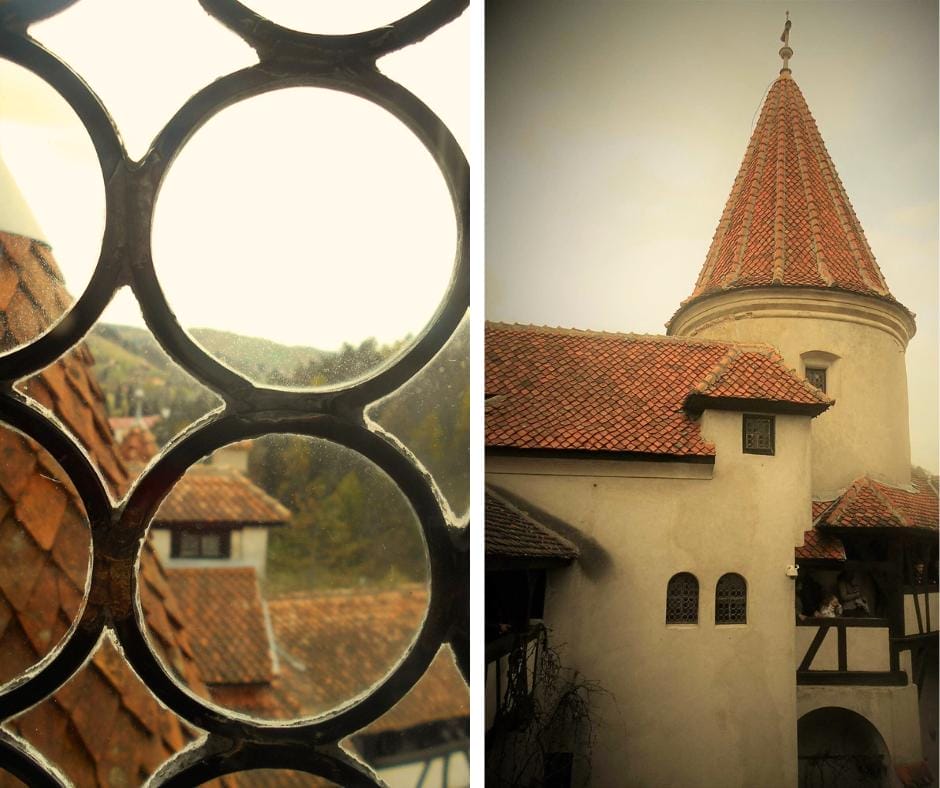
Inside, there are round fifty-seven rooms, many small and interconnected, creating a labyrinthine of secret passageways. There’s also a hidden staircase, discovered during renovations in the 1920s, that connects the first and third floors and believed to have been used in times of siege for a quick escape.
From the leaded tower windows there are panoramic views of Moeciu Valley and the Bucegi Mountains. The inner courtyard is surrounded by balconies and arched corridors and although in an authentically ruined state there is a beautiful stone well.
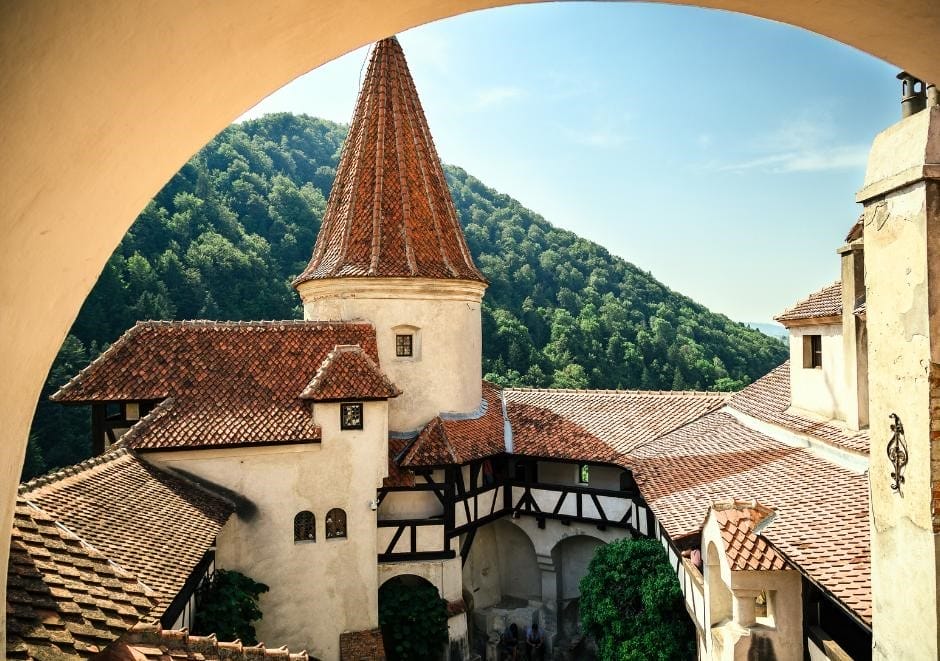
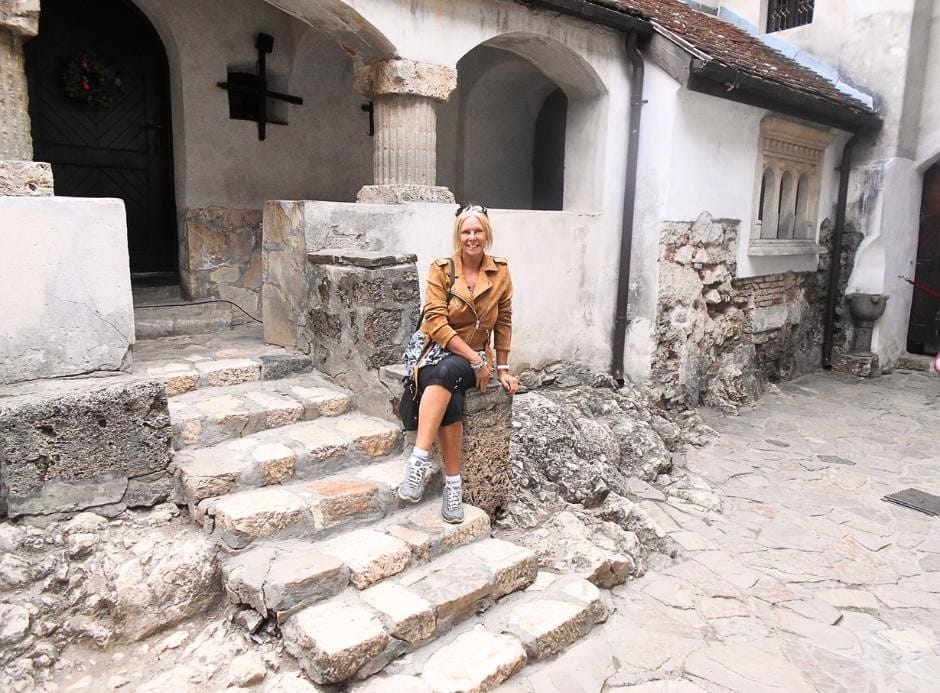

The castle also features exhibits on the historical figure who inspired Bram Stoker’s Dracula – Vlad the Impaler – along with medieval weapons, armour, and displays of his gruesome impalement methods (his signature punishment).
As Vlad’s nickname ‘Tepes’ literally means ‘The Impaler‘ in Romanian.

VLAD THE IMPALER (VLAD III DRACULA)
Vlad the Impaler notoriously executed enemies by impalement – a method where victims were skewered on long wooden stakes and left to die slowly.
Legend says he would sometimes dine among the impaled corpses, further fuelling his monstrous reputation. One of the most infamous stories comes from the Ottoman Sultan Mehmed II’s invasion of Wallachia in 1462 regarding the ‘The Forest of the Impaled’. When the Sultan entered Vlad’s forest, he found over 20,000 impaled corpses and thought it a war tactic so disturbing that it caused the invading army to retreat.
Some writings from the 15th century (German and Slavic sources) claimed Vlad dipped his bread in the blood of his victims which heavily influenced the later vampire mythos.
But in Romania, Vlad is seen more as a national hero than a bloodthirsty villain because he defended Wallachia from Ottoman conquest, protected peasants from noble exploitation, and is remembered for his uncompromising justice.
History also suggests that Vlad was likely killed in battle against the Ottomans around 1476. His head was reportedly cut off and sent to the Sultan in Constantinople as proof of death. The resting place of his body is still debated as no confirmed grave had been found. But some claims suggesting the Snagov Monastery near Bucharest where, during renovations, a headless body in royal attire was discovered, although it’s still debated as to whether it’s Vlad’s.
Klook.comVLAD’S TORTURE EXHIBITION AT BRAN CASTLE
Located in the castle’s basement or annex area, the torture chamber exhibit is a popular (and gruesome) addition to the museum. While it’s not part of the original medieval function of the castle it complements the ‘Dracula lore’ and reflects the authentic European torturous practices from the Middle Ages to the early modern era.
The Iron Maiden: A tall coffin-like sarcophagus lined with inward-facing spikes on which victims would be closed inside and then slowly impaled.
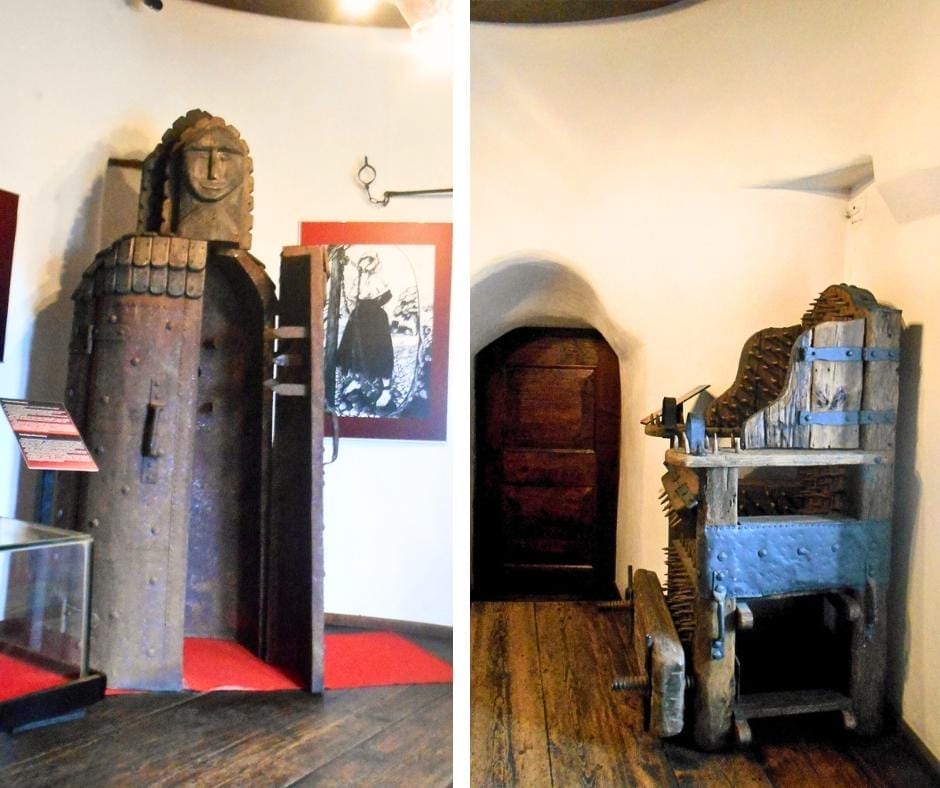
The Rack: Victim’s limbs were tied at each end of a wooden frame and stretched via a turning wheel. Commonly used during Inquisitions to extract confessions.
The Spanish Boot: Iron or wooden device clamped to the legs, then tightened or driven with wedges. It caused extreme crushing injuries.
The Heretic’s Fork: A metal rod with sharp ends placed between the chin and chest or the throat and breastbone to prevent movement. Often used on those accused of heresy.
The Catherine Wheel: Victims were tied to a large wheel and beaten or left to die and then often displayed publicly as a warning to others.
Thumbscrews, Branding Irons, Masks of Shame: Smaller tools used for public humiliation or interrogation. Masks of shame were iron or leather masks meant to ridicule and silence gossipers or heretics.
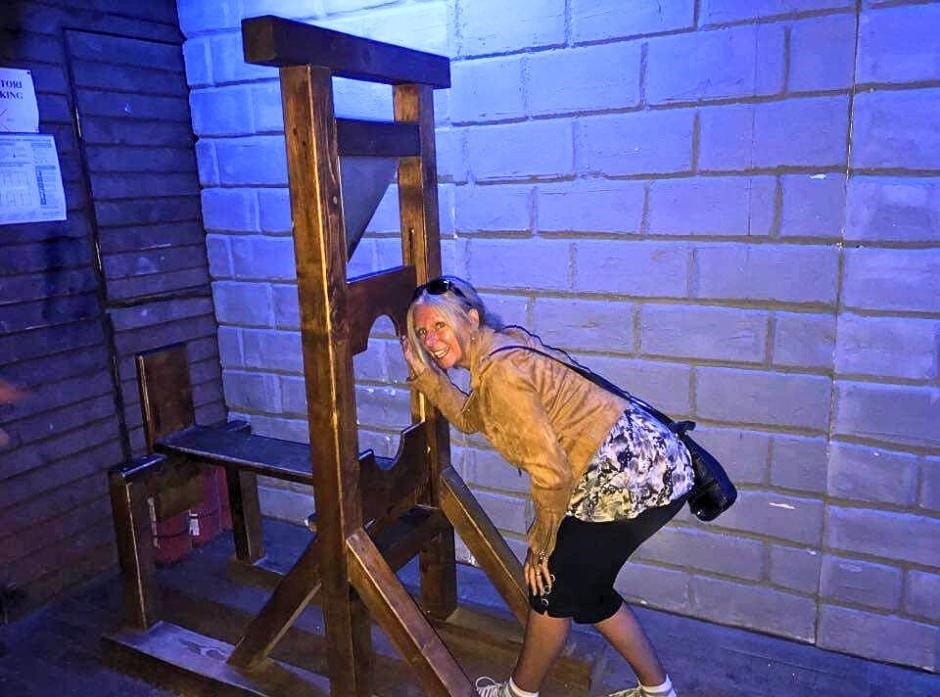
BRAM STOKER’S RESEARCH FOR DRACULA
Bran Castle draws hundreds of thousands of visitors yearly, especially when themed events are offered, yet Dracula’s author, Bram Stoker, (1847–1912) was an Irish writer, deeply interested in the supernatural, gothic literature, and folklore.
He worked for decades as the manager of the Lyceum Theatre in London, where he met intellectuals, actors, and travellers from around the world. He had a strong analytical mind, doing extensive research on Transylvanian history, vampire legends, and Eastern European culture despite never visiting Romania.
Indeed, it is said that the fictional castle in his gothic tale was inspired by both his imagination and from an etched drawing of a misty mountain fortresses that he’d seen in an old book while researching for his novel.
As Stoker was writing in the age of the Victorian Gothic revival, his literary influences included Emily Gerard’s essay called ‘Transylvanian Superstitions‘ (1885) which described Romanian beliefs in the strigoi and nosferatu.
He was also influenced by the works of Mary Shelley’s Frankenstein (1818), Sheridan Le Fanu’s Carmilla (1872), and Edgar Allan Poe’s Tales of Horror.
As Bran Castle strongly resembles the setting richly described in Dracula it was adopted in the 1970s by the Romanian tourism board as “Dracula’s Castle” and the myth stuck.
Interestingly, Bram Stoker’s original notes and his research for Dracula was discovered in the 1970s in a barn in Pennsylvania. These handwritten notes are now archived at the Rosenbach Museum in Philadelphia.
They reveal just how methodical and creative he was with records and timelines for all the main characters – especially the complex movements of Dracula, Harker, Van Helsing, etc, and of his long lists of Transylvanian superstitions – some are supposed to be real – and some are invented by him!
Early character name ideas were “Count Wampyr” (before he became Dracula). Wilhelmina” for Mina, which he kept, and “Van Helsing” was originally “Max Warkeli”
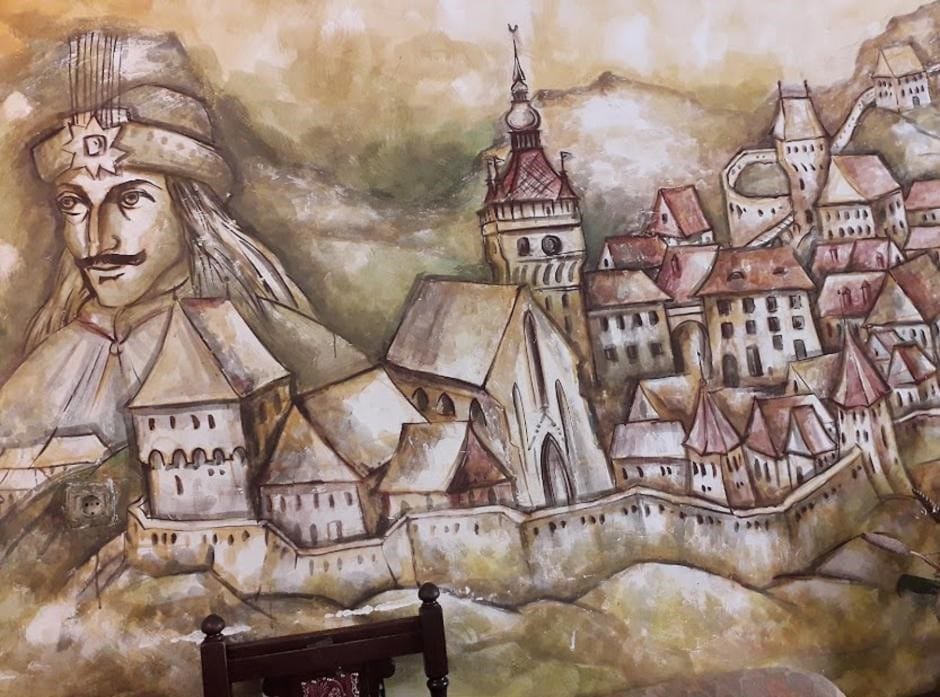
GOTHIC HORROR IN WHITBY ENGLAND
It’s thought that Bram Stoker may have chosen the name “Dracula” after reading about Vlad the Impaler (Vlad Tepes), a 15th-century ruler of Wallachia, in William Wilkinson’s 1820 book An Account of the Principalities of Wallachia and Moldavia, which he found in the local library in Whitby, England, which fuelled his inspiration for the gothic horror in his writing.
Bram Stoker stayed in Whitby in July of 1890, lodging at Mrs Veazey’s guesthouse at 6 Royal Crescent, and exploring the town and its surrounding landscape.
It seems the town’s dramatic ruins, like Whitby Abbey, and its dark history and its notorious association with shipwrecks, all provided inspiration for his novel’s gothic atmospheric setting.
From reading European folklore about undead beings who rise from the grave to drink blood or torment the living he then created supernatural traits for his vampire. He can’t go cross running water. He must sleep in native soil. He is repelled by sunlight, garlic, crucifixes, mirrors, and wooden stakes. He can change form into bat, wolf, or mist. Many of these are now recognised as vampire lore.
Here he also discovered that “Dracula” is a Romanian term that translates to “son of the dragon” but over time – as drac can also mean “devil” – it came to mean “son of the devil” which, of course, only added to the aura of superstition and medieval fear.
So, despite never stepping foot in Romania, Bram Stoker has shaped the world’s image of Transylvania and Dracula remains the most iconic vampire story ever written!

HOW TO VISIT BRAN CASTLE
You can visit Bran castle independently and drive to Bran Castle or you can take public transport using a bus or train and bus.
Drive from Bucharest – Take route DN1/E60 160km. Driving time approx. 2.5 hours driving time.
Drive from Brasov – Take route DN73/E574 30km. Driving time approx 35 minutes.
By Train/Bus: You can take the train from Bucharest to Brasov and then a bus or take a taxi to Bran Castle.
By Train from Bucharest to Brasov via Romanian Railways (CFR). Bucharest Nord Gara A. Hourly. (See Timetable). Distance is 170km and travel time approx. 3.5 hours
From Brasov you can then transfer to bus service or pick-up a local taxi service. For the bus – at terminal No. 2 in Brasov – the bus between Brasov and Bran departs every 30 minutes and every hour on weekends. Look for buses marked Brasov – Bran.
For more information on visiting times and special events go to the official Bran Castle Website. You can buy your tickets online and in advance (recommended) or on arrival at Bran Castle. Over 65’s get a discount on the ticket price (show ID).
Perhaps a more relaxing way to get there – and to make the most of a day trip from Bucharest – would be to take a guided tour. Guided tours often include visits to Brasov Old Town and other interesting old castles and palaces in the area.
I hope you’ve enjoyed my tour of Bran Castle and I hope you also want to read my other posts from my trip to Romania.

BEAT THE RUSH TO ROMANIA!
Right now, Romania’s capital city of Bucharest is often overlooked by tourists looking for a city break in favour of its Western European counterparts. But, from this year on, Romania’s tourist industry is being predicted to grow exponentially.
In fact, Romania has just been featured as a stellar destination in Vogue’s Where To Travel In 2025.
This means that while Bucharest might be underrated and uncrowded right now and you’ll likely be beating the tourist masses to enjoy a more authentic Romanian experience – that might not be the case very soon – especially in response to the impact of over tourism in other places in Europe like Paris and Rome and Venice.
This makes Romania a great budget friendly European capital and top destination for travellers on a budget, with lots of low cost flights into (OTP) Bucharest Henri Coandă International Airport (Aeroportul Internațional Henri Coandă București).
Bucharest is still shifting politically, economically, and culturally. Romania became a member of NATO in 2004 and part of the European Union in 2007 but in January 2025 it became a Schengen Area member. With the removal of border controls, Romania is sure to see increased tourism and trade with other Schengen countries in the very near future, potentially driving up prices and speeding up economic growth.
Clearly, there has never been a better time than right now to visit Bucharest and the rest of Romania!
WHERE TO STAY NEAR TO BRAN CASTLE
CLICK HERE TO FIND YOUR PERFECT PLACE TO STAY IN BUCHAREST VIA MY POST ON BUCHAREST
FIND YOUR PERFECT PLACE TO STAY NEAR TO BRAN CASTLE AND BRASOV USING THIS MAP

